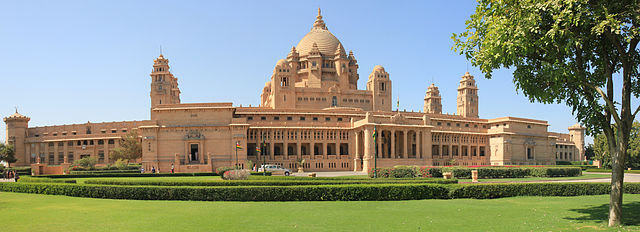Umaid Bhawan Palace
Circuit House Rd, Jodhpur, Rajasthan 342006
Phone : 0291 251 0101
Umaid Bhawan Palace, located at Jodhpur, is one of the world’s largest private residences. A part of the palace is managed by Taj Hotels. Named after Maharaja Umaid Singh, grandfather of the present owner Gaj Singh of the palace, this edifice has 347 rooms and serves as the principal residence of the erstwhile Jodhpur royal family. A part of the palace also houses a museum.
Umaid Bhawan Palace was called Chittar Palace during its construction due to use of stones drawn from the Chittar hill where it is located. Ground for the foundations of the building was broken on 18 November 1929 by Maharaja Umaid Singh and the construction work was completed in 1943. The Palace was built to provide employment to thousands of people during the time of famine.
Features
The Umaid Bhawan Palace is divided into three functional parts – the residence of the royal family, a luxury Taj Palace Hotel, and a Museum focusing on the 20th century history of the Jodhpur Royal Family.
Palace
The entire palace complex built with sandstone and marble is set in an area of 26 acres (11 ha) of land including 15 acres (6.1 ha) of well tended gardens. The Umaid Bhawan Palace, magnificent in its lavish proportions, consists of a throne chamber, an exclusive private meeting hall, a Durbar Hall to meet the public, a vaulted banquet hall, private dining halls, a ball room, a library, an indoor swimming pool and spa, a billiards room, four tennis courts, two unique marble squash courts, and long passages.
The interior central dome sits above the sky blue inner dome. The inner vaulted dome is a major attraction in the palace which rises to a height of 103 feet (31 m) in the interior part which is capped by an outer dome of 43 feet (13 m) height. The entry to the palace has decorations of the Coat of arms of the Rathore Royal family. The entry leads to the lobby which has polished black granite flooring. The lounge area has pink sandstone and marble floors. Maharaja Gaj Singh, known as “bapji”, stays in a part of the palace. The architecture of the palace is described as an amalgam of lndo-Saracenic, Classical Revival and Western Art Deco styles. It is also said the Maharaja and his architect Lanchester had considered the features of Buddhist and Hindu edifices such as the Temple Mountain-Palaces of Burma and Cambodia, and in particular the Angkor Wat in preparing the layout and design of the palace. The interior of the palace is in art deco design. The interior decoration is credited to J.S. Norblin, a refugee from Poland, who created the frescoes in the throne room on the east wing. An architectural historian commented that “it is the finest example of Indo-deco. The forms are crisp and precise”.
Museum
The museum has exhibits of stuffed leopards, a very large symbolic flag gifted to Maharaja Jaswant Singh by Queen Victoria in 1877, an impressive “quirky” collection of clocks in windmill and light house shapes, and photographs of the elegant art-deco interior of the palace. The classic cars of the Maharajas are also on display in the garden in front of the museum. Glass, porcelain wares, memorabilia, and information on the building of the palace are also part of the exhibits. The Darbar Hall, which is part of the museum, has elegant murals and also substantial number of miniature paintings, armour and an unusual collection of household paraphernalia that was in vogue in the 1930s, which were costly and then not found in India. October to March, during winter season, are the best months to visit the palace and the museum.
Source : wikipedia
A unique feature of this palace is the fact that the manually chiseled sandstone blocks have been put together in a special system of interlocking. There is no mortar binding. The museum which houses model aero planes, weapons, antique clocks, bob watches, priceless crockery and hunting trophies. Both sections retain the ambience of royal splendor.
The palace also has a collection of vintage cars like Rolls Royce Phantom 1927 model, Overland 1906 model, Cadillac 1947 model, Morris Minor, etc. This palace is visible from many places in Jodhpur, and shows us the luxury of the erstwhile Marwar state.
https://www.youtube.com/watch?v=5iCgoDhPgqM
Reviews
Visiting hours : 10.00AM to 04.30PM, all days of the week
Entry fee : Rs.30/- for Indians and Rs. 100/- for foreign tourists



Rate this article